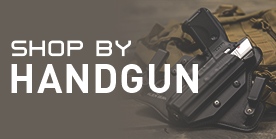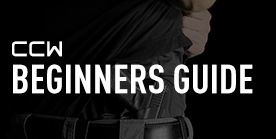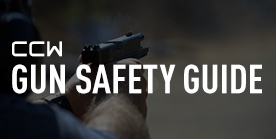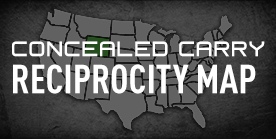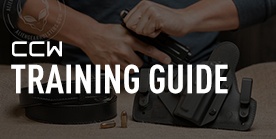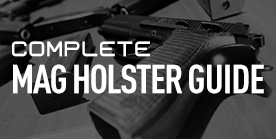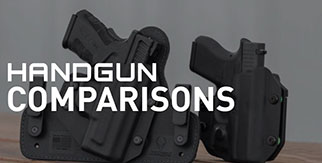
The 1911: Everything You Need To Know About It
Whilst the past couple decades have been dominated by Glock, there can be no doubt that the most popular and enduring pistol design of all time is the 1911 pistol. Even today they are among the most popular for daily carry, competition shooting, target shooting, other sporting uses and also for collectors. Few guns are as iconic.
Some might say the 1911 is an old design, but the truth is that it's an enduring design. Regardless of what plastic pistol fans might say, the fact is the 1911 still works and works well as a big-bore plinker, concealed carry or home defense gun and probably always will.
If you're considering the 1911 pistol as a CCW gun, or if you just want one to put in the safe to get what they're all about, this Alien Gear guide will give you just about everything you need to know.
John Moses Browning And The History Of The 1911 Handgun

Though the M1911 is arguably John Moses Browning's most famous invention, he looms large as the most brilliant and possibly most important firearms designer ever. Handguns and long guns designed by him or elements of his mechanical design survive to this day.
Besides the 1911, some of Browning's other designs included the Winchester 1894 rifle, the Winchester Model 12 shotgun (all modern pump-action shotguns descend from it) the M2 "Ma Deuce" .50-caliber machine gun and the Hi Power pistol. He even invented the first striker-fired pistol.
The pistol was single-action, fired by means a hammer that was cocked by racking the slide to load the pistol and then by every shot fired. Early models employed a "sight safety" that - when deactivated - served as the rear sight. Later models were intended to be carried with an empty chamber.
The basic tenets of operation proved sound, and the M1900 was submitted for testing in 1899. Initially, the pistol was chambered in .38 ACP (Automatic Colt Pistol) a Browning-devised cartridge that was nearly identical to .38 Super. The original load he developed, however, was a little too powerful for the gun he designed and it had to be watered down to 9mm Parabellum velocities.
To get some cash rolling in, Colt would offer each iteration of the design for commercial sale, with the Model 1900, Model 1902, Model 1903 and Model 1905 all having several thousand guns produced and sold.
The Army liked what they saw, but the gun wasn't quite ready for prime-time and they balked at issuing another .38-caliber pistol. The recent experience in the Phillipine-American war led them to prefer a .45-caliber cartridge, so Browning devised .45 ACP (essentially a rimless, trimmed-back .45 Colt load) for the Model 1905, the first gun offered in .45 ACP.
Further revisions were made to the Model 1905, mostly at the behest of the US Army since that's who Browning (and therefore Colt) were making the pistol for. The safety lever was moved to the rear of the frame, and a grip safety added at the request of the US cavalry. The tilting link at the barrel was replaced with a bushing, which held the barrel in place and reduced complexity.
The pistol went through a number of trials, culminating in a 1910 field test pitting the then-current iteration of the gun (the 1910 model) against a Savage Model 1907 chambered in .45 ACP. The trial was a 6,000-round torture test, with the only reprieve being dunking the gun in cold water if it got hot. The Savage suffered 37 malfunctions, but the Colt had none.
The US Army announced the Colt would be their new standard sidearm starting the following year, and thus dubbed it the M1911 (Model of 1911) pistol.
The M1911 Enters Service
The first combat deployment of the M1911 was in the Punitive Expedition of 1916 and 1917, when three brigades entered Mexico in pursuit of Pancho Villa after his attack on Columbus, New Mexico.
While the Punitive Expedition was underway, the German government sent the Zimmerman Telegram (inciting Mexico to wage war against the United States) which - along with the sinking of the RMS Lusitania and other incidents - prompting the United States to declare war on Germany.
Colt was the primary supplier, but couldn't keep pace with demand for new pistols for use in the war. The technical data package (TDP) was licensed to Remington, Springfield Armory - the ACTUAL Springfield Armory, not the company that's named Springfield Armory - and North American Arms for wartime production.
However, even manufacturing under license wasn't enough, and M1917 revolvers (full-size frame revolvers chambered in .45 ACP; they required little tooling to make) were also made by Colt and Smith & Wesson for the armed forces as a stop-gap.
The pistol acquitted itself well enough for a pistol in the war - such as Sgt. Alvin York's stunning single-handed capture of more than 100 German troops with one - but feedback from soldiers indicated revisions were necessary.
1911 Pistols Get An Update: The M1911A1
Original 1911 pistols worked well, but there were some complaints. To make the pistol a bit easier to operate, the following changes were made:
The hammer spur was shortened, and the grip safety spur was lengthened, to reduce hammer bite. The "double diamond" checkering on the grip was changed to a simpler pattern. The tang of the grip safety was enlarged for easier operation, and a shorter trigger blade was installed for better use with gloves and easier shooting by personnel with shorter fingers, and a scallop added to the frame behind the trigger guard. The slide was slightly revised and the sights slightly enlarged. The mainspring housing was changed from a flat design to an arched design to improve ergonomics.
The improved model was designated the M1911A1. David "Carbine" Williams - who, contrary to popular belief, had almost nothing to do with designing the M1 Carbine - also developed a .22 LR trainer variant, which Colt would make and sell to the military and civilians as the Colt Service Ace.
The M1911A1 would serve as the standard sidearm of the US armed forces (except for the Air Force, who issued the Smith and Wesson Model 10 revolver until the 1990s) from 1924 until 1986, when it was replaced with the M9.
1911 Pistols Continue To Develop
M1911 and later M1911A1 pistols were sold commercially as well as to governments.
Colt recognized a need for a hotter caliber for law enforcement purposes in the post-WWI era as police found themselves outgunned and out-equipped by gangsters in the Prohibition era. Common revolver calibers of the day such as .32-20, .32 Colt, and .38 Special didn't penetrate body armor nor were they much good for the car bodies and auto glass of the day. So they dusted off .38 ACP and goosed it with a bit of extra powder, creating a new round which they dubbed ".38 Super Auto" and in 1929, commenced to selling it to police.
It found some adopters, as the round was found to be (and still is!) potent, up to the task of penetrating the body armor and cars of the era. However, police of that time were mostly used to revolvers, which were and would remain the standard police sidearm in the United States until nearly the end of the 20th century.
Another issue was the ammunition. Expanding ammunition didn't really exist at the time; revolver bullets were cast lead and semi-auto bullets were primarily full metal jacket projectiles. Cast lead will deform, which matters as the deformation slows the projectile in tissue and helps to prevent overpenetration. Hardball (FMJ) bullets do not, which is problematic in an LE context. Additionally, .38 Super was hard to find in stores and was expensive.
When the .357 Magnum cartridge was released in 1934, it was easier for law enforcement (and the shooting public) to adopt. So while the .38 Super pistols did find some adoption, it was limited.
In the late 40s/early 50s, the Army floated the idea of replacing the M1911A1 with a smaller, lighter pistol in 9mm. A few different pistols were submitted for trials (a few Hi Power variants and the S&W Model 39) but Colt's version was a trimmed-down 1911, with a 4.25-inch barrel, shortened slide and ring hammer in lieu of the standard spur, as well as an aluminum alloy frame to save weight. The gun was dubbed the "Colt Commander" also known as the "Commander frame."
The Army ultimately decided against adopting the Commander, but Colt decided to produce and sell it commercially. The pistol was offered in 9mm as well as .45 ACP and .38 Super.
The Rock Island Arsenal, the Army's munitions manufacturing facility, produced the M-15 General Officer's Model Pistol in 1975, which was basically a standard M1911 chopped down to Commander specs and fitted with taller sights.
By the 1980s, various firms besides Colt were manufacturing 1911 pistols. These ranged from reproductions of the GI-spec "Government frame" full-size pistols to compact models for concealed carry. Some were (and still are) budget models for the bare-bones shooter to highly accurized pistols for competition shooting, handmade custom guns for display or as personal sidearms to those who can afford them and all points in between. During this decade, the 1911 was retired from military service in lieu of the Beretta 92/M9, though some units still issue 1911 pistols.
Colt kept a certain amount of pace, releasing the Series 80 design in 1983, which featured a trigger-actuated firing pin block as a drop safety. This was followed by the Colt Officer's ACP - the Officer frame - in 1985, and the Delta Elite chambered for the 10mm cartridge in 1987. However, Colt - for a variety of reasons - is no longer a dominant force in handgun manufacturing nor even among 1911 producers. In their place, a plethora of makers have risen offering a fantastically diverse array of takes on the platform.
The Dawn Of Custom 1911 Pistols
In the post-war era, a whole bunch of people wanted to know how to make 1911 pistols better. More accurate, easier to use, more reliable and so on.
Part of this was spurred on by the the nascent practical shooting sports. Prior to World War II, about the only competitive shooting was either trick shots (Annie Oakley, Ed McGivern) and bulls eye (strictly accuracy, slow-fire) events including Olympic pistol competitions, and accurizing the M1911 for NRA Bullseye was a known practice by the 1930s. Custom bullseye pistols gained even more popularity in the post-war era as NRA Bullseye started to regain popularity in the 1950s.
However, a few cowboys, police officers and former military guys started coming up with tests of marksmanship under time constraints that simulated combat shooting. It started with the Big Bear Leather Slaps in the 50s, and was largely led by Jeff Cooper, with help from shooters like Ray Chapman, Jack Weaver, and eventually culminated in shooting leagues like IPSC (International Practical Shooting Confederation) and the International Defensive Pistol Association or IDPA.
Competitors wanted to improve the guns for better use in competition, which led to a cottage industry of gunsmiths developing tuning techniques and fabricating new accessories and so on to make the pistol better. Early smiths like Frank Pachmayr, Jim Clark and Armand Swenson went about improving the pistols, which led to many of the features that are common on 1911 pistols today.
Extended beavertail grip safeties, extended thumb safety levers, hand-fit barrels, adjustable target sights, ambidextrous safety levers, checkering, trigger and action jobs for an easier, smoother pull and more reliable operation, melt treatments to keep the frame from cutting clothing and drawing easier...all of these features which are now standard on 1911 pistols on store shelves nationwide were all developed by these gunsmiths.
The tradition of these smiths was carried on by later gunsmiths like Bill Wilson, Les Baer, Ed Brown and others. Their innovations changed the 1911 pistol substantially, as it's no longer just the GI-style model by Colt anymore.
The 1911 Today
Today, dozens of companies make a 1911 pistol. As a result, the gun can virtually be "all things to all men" as the diversity of features and configurations mean there's a 1911 for practically anyone. Just about anyone can find a 1911 pistol to suit their needs and at almost any price point.
If you're looking at getting a 1911, the question really becomes about balancing how much you're willing to spend and what you want out of the pistol in terms of features and specifications. Given the diversity of firms making them, you'd be surprised at how much you can get for the money.
The 1911 Frame System

Whilst the 1911 frame was at one point limited to just one size, there are currently three "frame" sizes for most 1911 pistols, roughly corresponding to full-size, compact and subcompact sizes. There are also a number of micro-sized pistols that have 1911-derived designs as well.
Government frame: the "Government" frame is the full-size pistol. Barrel length is 5 inches, for an overall length of 8.25 inches. Height is usually 5.5 inches, and width is typically about 1 inch at the slide and around 1.2 inches at the grip.
Commander frame: the "Commander frame" is derived from the Colt Commander of 1950, and is a very popular compact model that some prefer for concealed carry. In truth, "compact" is somewhat relative. A true Commander 1911 has merely had ¾" shaved off the barrel and slide, but is otherwise the same size.
Officer frame: the Officer 1911 is the subcompact variant. Standard barrel length is 3.5 inches for most models from most manufacturers, though there are shorter barrel lengths out there. The grip is also shortened, as most Officer frames are 4.8 inches in height or shorter.
There is some overlap between Commander and Officer frames. The original version - the Rock Island Arsenal Officer's pistol was a Commander slide with a shortened grip, and a number of 1911 pistols with a Commander slide and barrel but Officer frames are available to date.
Micro 1911 pistols, like the Kimber Micro, Sig Sauer P238 and P938, and the Colt Mustang, take many cues from the 1911. These pistols are micro-sized and are highly popular for concealed carry, though are chambered for .380 and 9mm only. The single-action operation remains, as does the thumb safety, but the grip safety is omitted.
The 1911 Today

The 1911 pistol today is made by dozens of companies, in dozens upon dozens of permutations and with a plethora of options available. Additionally, there is a wealth of aftermarket support includes parts, accessories, 1911 holsters and so much more.
Given this bounty of 1911 options, the pistol can be all things to all men - and nearly anyone can find a 1911 pistol meeting their needs, including price point. However, there are also handmade custom guns from the highest of high-end makers available as well, which can easily run upward of $2,000 or more. Spending $4,000 on a 1911 pistol is not unheard of in the least.
For the entry-level shooter, 1911 pistols with fewer features and refinements are available at reasonable price points ranging from less than $400 to just under $800, depending on the manufacturer. There may be a few bonuses thrown in, such as the odd set of combat sights or beavertail grip safety, but many will be not too different from the standard issue model formerly issued by the US government, including front and rear blade sights.
Some people may be looking for that, however, and there are WWII reproductions available for those shooters as well as people who are just looking for a solid 1911 pistol on a budget.
For the concealed carry crowd, there are still a great number of 1911 pistols available for this role. The Government frame is arguably the most popular full-size gun for concealed carry, as the slim dimensions - less than an inch at the slide, no more than 1.3 inches at the grips - allow it to be concealed more easily than the double-stack "wonder nines" of the modern era. Both IWB and OWB concealed carry with a full-size is easily done.
Commander frames are not much smaller than the Government frame, but the Officer frame pistols are certainly the 1911 pistol to have for a CCW gun.
As to caliber, the 1911 is available in a wider range of chamberings because the gun has become a shared platform. As a result, you can find 1911 pistols in the classic .45 ACP, but other popular chamberings include 9mm, .38 Super, 10mm and the odd .40 S&W; there are also a number of .22 LR pistols for plinking, and there are a small number of ¾-size 1911s in .380.
Boutique makers have also brought some rare chamberings to the platform, including .50 GI, .460 Rowland, the odd .45 Super, essentially an ACP +P+, and even .357 Magnum.
As far as amenities, there are many to be had. Ambidextrous thumb safeties are popular upgrades, as are extended beavertail grip safeties, upgraded sights including night sights, adjustable target sights and so on, accessory rails and many more.
What To Look For In A 1911 Holster

There are a number of attributes you should look for in a 1911 holster. For starters, you should get what you need from any decent holster - comfort, concealability and adequate retention.
That said, the need for truly comfortable concealment can be thrust into sharp relief by carrying the 1911 and especially if carrying inside the waistband. The gun has relatively straight sides but the thumb safety can protrude a bit. If an IWB holster lacks adequate padding, you may feel it through the holster and that isn't necessarily pleasant.
How the thumb safety interacts with a holster is a key attribute as well. The 1911 is best carried in Condition 1, or "cocked and locked" where the hammer is cocked and the manual safety engaged. Some holsters, due to how the gun rides in them, may snag the safety and deactivate it. This isn't necessarily a safety hazard - the 1911 has a grip safety that must be depressed in order for the trigger to be pulled - but that doesn't mean this should be overlooked.
Given the weight of the pistol, it may also be desirable to find a holster that spreads the weight out to a certain degree. IWB holsters with flexible wings are best suited for IWB deployment, and OWB holsters should at least have a solid belt attachments method, such as a hard plastic paddle or solid belt slide attachment.
Living With The 1911 Pistol

The 1911 pistol is an American icon, but there are some known shortcomings. Capacity is limited by modern standards and the pistol is large and heavy, especially relative to capacity.
A 1911 pistol requires more attention than modern pistols. The slide, frame and other parts have to be kept clean and lubricated for best function; it will not tolerate neglect and doesn't tolerate abuse well.
Then there's the single-action, hammer-fired operation. This necessitates carrying either with an empty chamber - requiring the slide to be racked if drawn, which is nearly impossible with only one hand and time-consuming - or the gun must be carried with the manual safety engaged or "cocked and locked." That requires the safety to be disengaged if the pistol must be drawn, which requires training to commit to muscle memory.
While some people feel the cocked hammer means a greater chance of an accidental discharge, the truth is a cocked and locked 1911 has several redundancies in place. First, the manual safety locks the hammer and the grip safety - when not being deactivated by holding the pistol - blocks the sear, preventing the trigger from tripping the hammer. Lastly, if a pistol is of Series 80 design, there is also a firing pin block that can only be deactivated by pulling the trigger. Thus, a Series 80 1911 has three safeties engaged while carrying in this manner.
Another thing to be aware of is the Achilles' heel of the 1911 pistol is the magazines. Factory mags can be of varying quality; some are great and some should be tossed straight away. As a result, it's a good idea to invest in some quality magazines. MecGar, Chip McCormick and Wilson Combat are very popular brands.
The extractor is another common failing; it has to be adjusted to maintain proper tension periodically unlike...pretty much any other extractor design found on any other pistol.
Like any mechanical system, there are inherent limitations. Once they are understood, and the operator takes care of the pistol as it is supposed to be cared for - meaning kept clean and well-oiled for best operation - it is a reliable, accurate pistol platform.
Why Buy A 1911?

Given all this, why is the 1911 pistol so popular? For several reasons. A decent example, with moderate care, is a powerful, accurate and reliable sidearm that can be trusted to save your life if needed. It is also one of the darlings of competitive shooters.
The ergonomics are also a strong selling point. Few guns sit in the hand and point as naturally. Some find this makes for more intuitive aiming and thus easier accurate fire.
There is also the trigger. Many shooters find the 1911 trigger better than almost any other pistol in existence, even on what some would consider lower-end guns. Good 1911 triggers have minimal creep, with a crisp single-action break and many are fantastic out of the box.
Part of this is the trigger design. Most triggers are a lever, which must be pulled to the rear to trip. The 1911 trigger travels straight back, riding in grooves for a smooth, short travel. As a result, trigger control is not difficult with many 1911 pistols, a feature many appreciate.
Another appeal is the generous aftermarket support. The sheer number of aftermarket parts and accessories for the gun is astounding. Just like a muscle car, you can buy a "beater heater" and customize it to your satisfaction. Take a budget gun and add the bits you want until you've created the gun of your dreams.
These are some of the reasons why so many people have one or more 1911 pistols for recreational shooting, personal protection, service use and also sport shooting, as 1911s are very common competition guns. The gun is also an American icon, a piece of Americana, and an enduring one.
 |
About The Author Born in southeastern Washington State, Sam Hoober graduated in 2011 from Eastern Washington University. He resides in the great Inland Northwest, with his wife and child. His varied interests and hobbies include camping, fishing, hunting, and spending time at the gun range as often as possible. |



